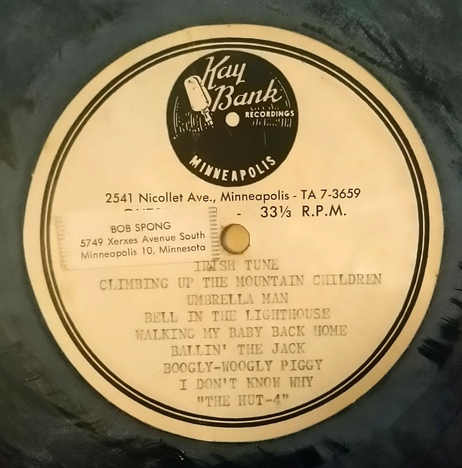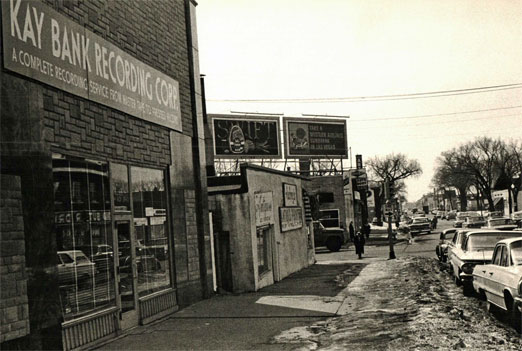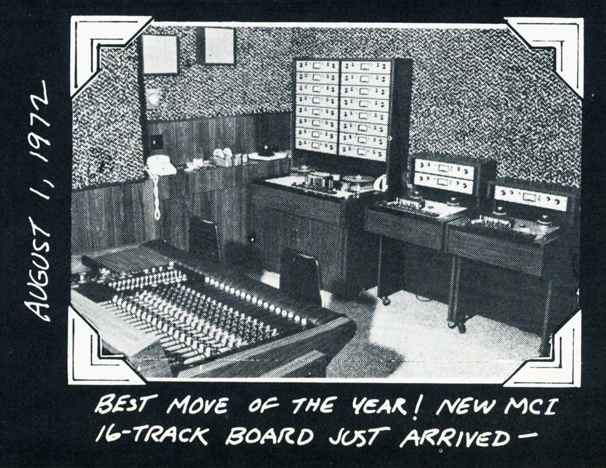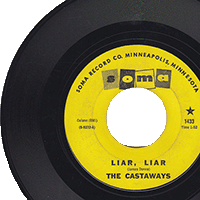Kay Bank Studio
Many thanks to Derik Olson, local music expert, for help with his research for this page!
Quite a number of notable recording studios have made their home in the building at 2541 Nicollet Ave. in Minneapolis. This building, which still stands after 100 years, had a huge influence in Twin Cities entertainment. This page covers only the recording studios that have been in this building; for other recording studios in the Twin Cities, please see Twin Cities Recording Studios.
- Swedien
- Kay Bank
- Universal Audio
- Micside
- Cookhouse
- Nicollet
- Creation Audio
GARRICK/LASALLE THEATER
The building’s first use was as the Garrick movie theater, which opened on June 8, 1914, by John C. Karisen, a marathon runner and skater. There were many Garrick theaters, named after an English actor. In October 1932 the name changed to the LaSalle Theatre. It closed in 1950, and was listed for sale in September 1951. There may have been some interim businesses in the building.
SWEDIEN STUDIOS
Bruce Swedien was born April 19, 1934, in Minneapolis. After majoring in electrical engineering (and minoring in music) at the University of Minnesota, audio engineer Bruce Swedien became the operator of the Schmitt Music company’s recording facility.
In 1953 he bought Schmitt’s equipment and moved it into the theater, converting it into Bruce Swedien Recording Studio. “My wife helped glue up the egg cartons,” he said, referring to the dozens of empty containers still visible in Studio B. “They were a superb and very cheap acoustical treatment.” “I built those doors; if you look carefully at them, you’ll see they’re very solid, very thick,” he said proudly, peering at the dark-pink 4-inch-thick doors to Studio A. “This place is unbelievable. My whole life started here.”

Self-taught, Swedien recorded mostly jazz, including some national acts like Art Blakey and the Jazz Messengers and Herbie Mann, but also the Six Fat Dutchmen and the Herb Pilhofer Octet.

In 1957, a CBS Radio broadcaster was traveling through the Dakotas on assignment and Swedien was hired as a sound engineer. That led him to Chicago, where he joined RCA Victor studios and recorded the Chicago Symphony and many jazz artists, including Duke Ellington and Stan Kenton. His break came as engineer for Frankie Valli and the Four Seasons’ smash single “Big Girls Don’t Cry” in 1962. He also joined forces with Quincy Jones, which led him to work with some of the biggest stars. He moved to Los Angeles in 1975, and then to New York in 1977 to engineer sessions for the movie “The Wiz.” He met the film’s star, Michael Jackson, and went on to engineer the superstar’s biggest albums.

(Material taken from the Minneapolis Star Tribune, May 10, 2013 – article by Jon Bream)
Bruce Swedien died on November 16, 2020.
KAY BANK STUDIOS
1946
The story of Kay Bank Recording begins with Vernon Charles Bank. He worked at the Minneapolis Star and Tribune from 1938 to 1951, except for three years during World War II. Vern served as an Army special agent in the Counter Intelligence Corps from 1942 to 1945 and received the Bronze Star for meritorious achievement in the Southeast Pacific. Cedric Adams reported that Vernon C. Bank was a “copydesk” man at the Minneapolis Star, (Jon Bream said that he wrote headlines and captions).
Vern first got into the recording business in 1946 when he bought a wire recorder for $400. He had intended to record weddings, but found no market for such recordings. He did find a demand for choir recordings, however, and he and and his wife Kay purchased disk-cutting equipment for such choir recordings.
In 1948 they expanded again with tape recording equipment, and moved their equipment out of their kitchen at 3718 Glendale Terrace and into the living room of their new home at 4049 Garfield Ave. There they would cram bands for recording on the side while he was still working full time at the Minneapolis Star and Tribune. (Minneapolis Tribune, April 9, 1958)

1951
In 1951 the Banks decided to dedicate themselves to the recording business full time, and incorporate, using Vernon Bank’s name. Cedric Adams told the story of the problems associated with incorporating a business by a man named Bank:
Strange was the situation of a gent who found he couldn’t use his own name in business. He’s Vern Bank, one of our Star copydesk men. For some time, Bank and his wife, Kay, have been operating a recording business on the side. Now they’re expanding and re-locating downtown. To do this they incorporated. And to incorporate they had to have a firm name. They found the name Bank was out, though; state law provides that the word “bank” can’t be used in a business name unless the business is really a bank. To get a title they contracted Mrs. Bank’s moniker, and the new firm is Kaybank, Inc. There’s a bit of solace, however; on the firm’s letterhead the name can be Kay Bank, Inc. (Minneapolis Tribune, August 19, 1951)
They sold stock to friends and those associated with the recording industry. (Minneapolis Tribune, April 9, 1958)
They set up their first studio at 111 N. 11th Street in Downtown Minneapolis in 1951.

1952
A newspaper search for Kay Bank gleaned some interesting results. In 1952, Cedric Adams described a new music-announcements system at the airport (then called Wold-Chamberlain Field), where soft music plays through 38 speakers, except when flight announcements were made. The announcements were made by 104 pre-recorded records listing flight data, recorded by Frank Butler at Kay Bank studio. Some complicated bit of business was explained in the event that more records were needed. The system took two years to plan and $13,000 to implement. It was the second behind Seattle to be put in use. (Minneapolis Star, December 18, 1952)

1953
Here they are in a man-on-the-street interview feature in the Minneapolis Star, October 17, 1953

1956
The Boutrous Plating Co., formerly of Owosso, Michigan, moved to Minneapolis in 1956 to join forces with Kay Bank. The firm specialized in plating acetate master records with copper, nickel, and chrome to form master disks for the manufacture of records in quantity. Using this process made it possible to produce records within 72 hours of the time of taping, shortening the time from two weeks. (Minneapolis Star, November 21, 1956)
1957
The Banks had to send recordings to the West Coast to be cut, so in 1956 they decided to set up their own pressing plant. Kay Bank’s pressing plant at 2129 Washington Ave. N opened in January 1957. (Minneapolis Star, August 9, 1957)
On August 12, 1957, Kay Bank moved from its previous location on Eleventh Street to the former Swedien Recording Co. at 2541 Nicollet Ave. The move doubled the studio’s capacity.
Also in August, two more record presses were being installed at the Kay Bank pressing plant at 2129 Washington Ave. N., bringing the number to five. (Minneapolis Star, August 9, 1957)
One of Kay Bank’s biggest customers was Amos Heilicher, who along with his brother Dan, owned one of the largest record labels (SOMA) and distributors in the U.S. By 1964, the success of Dave Dudley’s “Six Days on the Road” and the Trashmen’s “Surfin’ Bird” had put the studio on the map, and bands were coming in from all over. Randy Bachman brought an early version of the Guess Who down from Winnipeg to get the “Kay Bank sound” (three-track recording and echo!). The Heilicher’s SOMA label began sometime between November 1953 and November 1954 and Doc Evans was the first record. (SOMA was Amos spelled backwards.)
Kay Bank offered an attractive package to local bands: For $395 you’d get three hours in the studio, a thousand 45s, and 50 promo packages delivered to radio stations in the Midwest. For $1,000 an artist could get an entire album recorded. Several Kay Bank clients, such as “Liar, Liar” by the Castaways, wound up on the Heilicher brothers’ record label, Soma.
The studio booked daytime sessions for commercial jingles and film scores; from 4 pm to 3 am, rock bands recorded demos or albums on local labels. (Jon Bream, Minneapolis Tribune, May 7, 1989)
1958
This is odd. Kay Bank had something called an “Ear-Picture Room” that contained a file of five-minute tape records of performers listed in the Twin Cities talent directory. People looking to hire a particular kind of voice can go listen to the sample tapes at the audition room. Unclear whether this really happened. (Minneapolis Tribune, April 2, 1958)
Kay Bank claimed that it had the most complete recording facilities of any plant between Pennsylvania and California. It had two studios, each its own echo chamber (important in 1958!) Recordings included radio commercials, flight announcements, radio shows, news broadcasts, singers, and choirs. By 1958 they were pressing 60,000 records a week, using six presses. The company had 18 employees. (Minneapolis Star, April 9, 1958)

1959
In June 1959, Bobby Vee and the Shadows recorded “Suzie Baby” (written by Bobby) at Kay Bank. The record was distributed nationally on the Liberty label. (Sunday Tribune Picture Magazine, feature on Bobby Vee, February 17, 1963)
1964
That Minnesota hotdish of culture, “Surfin’ Bird,” by the Trashmen, had been recorded sometime in 1963, and by January 1964 it was the top of the heap nationally, soon to be knocked off by those Limey twits, as they are known in some circles. But on January 13, 1964, it was time to celebrate the success of the song that ultimately made the T-Men no money, and to launch two new works: the single, “Bird Dance Beat,” and the Brilliant LP “The Trashmen.” A party was held at Kay Bank, hosted by officials from SOMA, the distributor; Garrett Records, the producer; and Kay Bank. The party was attended by disk jockeys, “record peddlers,” and “a few young persons whose function was to dance The Bird.”
Larry LaPole was also there, and he thanked Will Jones for inspiring several of the songs he wrote. On July 28, 1963, Jones had filled his column with a glossary of surf terms. When the Trashmen needed a flip side to “Surfin’ Bird” in a hurry, they turned to Larry, who in turn turned to the column for his vocabulary. That particular song was “King of the Surf,” the best Surf Song ever written, in my opinion! Larry also wrote several other songs, including “A Bone,” which was the flip side of “Bird Dance Beat.” Larry’s songs on the new LP included “My Woodie” and “Sleeper.” (Minneapolis Tribune, January 15, 1964)
An ad for Kay Bank Recording Corp. in the 1964 AFTRA Catalog cites John Michaelson as studio manager and Vern Bank, President. Equipment included:
- Ampex Recorders (1, 2 & 3-track)
- Echo Chambers
- Three Studios, Air Conditioned
- Telefunken, RCA, Electrovoice, Sony Mikes
- Hammond Organ, Celeste, 2 Grand Pianos
- DuKane Tone Generator
- Line Equalization
- Scully Mastering Lathe
- Completely Automated Record Pressing Plant





1966
In 1966, columnist George Grim stated that the Banks ran the “Largest independent recording and record-producing operation in the country.” Kay Bank had just opened a manufacturing plant in Charlotte, North Carolina in February 1966. Vern was proud of his capacity to produce as many as 25,000 records in a triple shift day. He had a dozen presses, and “new made-in-Sweden automatic electroplating automations.” (Minneapolis Tribune, March 31, 1966)
WINDING DOWN
In early 1967 Vernon Bank sold his 50 Percent interest in Kay Bank to Jan Jansen, who had 40 Percent. He became a consultant in September 1967.
In April 1968, stockholders of Kaybank, Inc. voted to change the name of the company to Sentinel Record Corp. The address of the company was given as 2129 Washington Ave. N, which was the pressing plant that had opened in January 1957.
Vernon officially “Quit” Kay Bank a/k/a Sentinel Record Corp. on January 1, 1968.
UNIVERSAL AUDIO SALES CORP.
Sometime in 1967, Bank also sold his 1/3 interest in Universal Audio to Jan Jansen, Herb Pilhofer, and Don (John?) Michaelson. The company had 60 employees.
(Minneapolis Star, December 25, 1967)
VERNON AND KAY BANK
Vernon Charles Bank was born in Milltown, Wisconsin, on December 31, 1913, and was educated in journalism. He worked at the Minneapolis Star and Tribune from 1938 to 1951, except for three years during World War II. Vern served as an Army special agent in the Counter Intelligence Corps from 1942 to 1945 and received the Bronze Star for meritorious achievement in the Southeast Pacific. From 1968 to 1970 he worked for the Albuquerque Journal, and in 1970 to 1984 he was an editor with the Tucson Citizen. He died on March 15, 1994, at the age of 80. (Tucson Citizen, March 16, 1994)
Mary Kathleen (Kay) Bank was born on January 18, 1919 in Cheyenne Wells, CO. As a young woman she worked as the personal secretary to the director of the Colorado Farm Security Administration in Denver. She met and married Vernon Bank in Denver in 1943. Kay died on March 28, 2005 in Tucson of congestive heart failure at the age of 86.

UNIVERSAL AUDIO (UA RECORDING)
An ad dated January 30, 1967, puts U.A. Audio-Video Sales and recording studio at 2541 Nicollet. The classified ad emphasizes sales of equipment, with just a line at the bottom to indicate the recording aspect of the business. Subsequent ads are for Ampex recorders for $200.
Finally on June 13, 1967, Will Jones tells us that Herb Pilhofer has purchased the place, with John H. Michaelson, who had been chief engineer at the studio. The ad below, from the July 29, 1967, issue of the Insider, announced that the building was now occupied by UA Recording. Michaelson was President, and Pilhofer was Vice President. The obituary of Michaelson says that he started the business and moved it to Phoenix in 1970.




MICSIDE: 1970 to 1973



COOKHOUSE

Late 1973 to 1984. Vocalist Arne Fogel can attest that “During the 1970s, hundreds of jingles, records, film soundtracks, etc. were recorded there. The creative force behind much of Cookhouse’s activity during those years was Dale Menten of the Gestures (“Run Run Run,” “House of Leather”) fame.”
NICOLLET STUDIOS
1985, with Twin/Tone records.
CREATION AUDIO RECORDING
The building was last sold in 1988, and the current owner is listed as Creation Audio Recording, Inc. David Allan Wright tells us that Creation Studio started on Old Shakopee Road in Bloomington attached to a house, with a train track behind the house.



